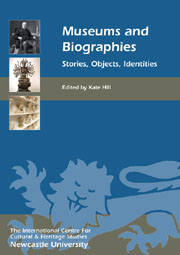Book contents
- Frontmatter
- Contents
- List of Illustrations
- Introduction: Museums and Biographies – Telling Stories about People, Things and Relationships
- INDIVIDUAL BIOGRAPHY AND MUSEUM HISTORY
- PROBLEMATISING INDIVIDUALS' BIOGRAPHIES
- INSTITUTIONAL BIOGRAPHIES
- OBJECT BIOGRAPHIES
- MUSEUMS AS BIOGRAPHY
- MUSEUMS AS AUTOBIOGRAPHY
- Endpiece: The Homunculus and the Pantograph, or Narcissus at the Met
- List of Contributors
- Index
Introduction: Museums and Biographies – Telling Stories about People, Things and Relationships
Published online by Cambridge University Press: 05 February 2013
- Frontmatter
- Contents
- List of Illustrations
- Introduction: Museums and Biographies – Telling Stories about People, Things and Relationships
- INDIVIDUAL BIOGRAPHY AND MUSEUM HISTORY
- PROBLEMATISING INDIVIDUALS' BIOGRAPHIES
- INSTITUTIONAL BIOGRAPHIES
- OBJECT BIOGRAPHIES
- MUSEUMS AS BIOGRAPHY
- MUSEUMS AS AUTOBIOGRAPHY
- Endpiece: The Homunculus and the Pantograph, or Narcissus at the Met
- List of Contributors
- Index
Summary
‘As long as there's a story, it's all right’
Graham Swift, Waterland (Swift 2010, 68)Biographies and museums both lie in a grey area of knowledge and affect; they tell us about what happened, but also form emotionally compelling and satisfying narratives. They mediate the academic and the popular, spanning the physical and imaginary worlds. They are linked by an ability to tell us about ourselves and our world as moving through time, but also serve to immortalise, to freeze in time. Above all, when museums and biographies come together or overlap, what we get is relationships: between people, between people and things, and between people and buildings. Moreover, museums and biographies together highlight questions around how we know and communicate the past, and to what extent our selves are separate from both other selves and the ‘object’ world. They prompt us to ask how far we can interact with the materiality of the museum to develop our relationship with others, alive or dead, and whether objects can be active agents in those relationships. They suggest questions about identity as process and relationship.
On the other hand, biographies have subjects, while museums have objects. In bringing the two together are we not transgressing some fairly fundamental ways of thinking and understanding the world? Certainly the 19th-century canonical museum was concerned to develop an objective, systematic representation of the world as knowable by the Western subject, while the biography promised to offer an understanding of the subjectivity of the great man; the ‘existential and perceptual textures’ of that life (Kaplan 1978, 2; Clifford 1978, 42).
- Type
- Chapter
- Information
- Museums and BiographiesStories, Objects, Identities, pp. 1 - 10Publisher: Boydell & BrewerPrint publication year: 2012



